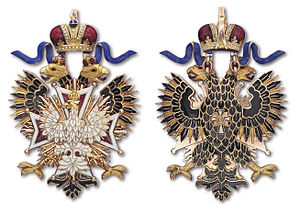Order of the White Eagle (Russian Empire)
 From Wikipedia the free encyclopedia
From Wikipedia the free encyclopedia
| Imperial Order of the White Eagle Орден Белого Орла | |
|---|---|
 Grand Cordon set | |
| Awarded by | |
| Type | Dynastic Order |
| Royal house | House of Romanov |
| Religious affiliation | Russian Orthodox |
| Motto | Pro Fide, Rege et Lege For Faith, The King and The Law |
| Status | Rarely constituted |
| Sovereign | None |
| Grades | Knight |
| Precedence | |
| Next (higher) | Imperial Order of St. Prince Alexander Nevsky |
| Next (lower) | Imperial Military Order of St. George |
Ribbon of the order | |
The Imperial Order of the White Eagle (Russian: О́рден Бе́лого Орла́) was an Imperial Russian Order based on the Polish honor. Emperor Nicholas I of Russia established the award in 1831 as the Imperial and Royal Order of the White Eagle. A recipient of the Order was granted the title Knight of the Imperial (and Royal) Order of the White Eagle.
Background[edit]
The "white eagle" has been associated with Poland even prior to statehood; first appearing on the Polish Coat of Arms in the 13th century.[1] The original Order of the White Eagle (Polish: Order Orła Białego) was reputedly established by King Władysław I in 1325. There is no evidence of it being awarded, however, until 1705 under Augustus II the Strong, King of the Polish–Lithuanian Commonwealth.[2]
After the Third Partition of Poland in 1795, the Order of the White Eagle briefly disappeared along with the Polish monarchy. After his death in 1798, Empress Alexandra wore the Collar of the Grand Master of the Order at Nicholas’s coronation as King of Poland.[3] The order was resurrected in 1807 by Napoleon I in his short-lived Duchy of Warsaw.[2]
In 1815, the Congress of Vienna divided the historically Polish lands among Prussia, the Austrian Empire and the Russian Empire. The majority of the territory was renamed the Kingdom of Poland and was to be an autonomous part of the Russian Empire.
The Order of the White Eagle is mentioned as belonging to the Kingdom of Poland in its constitution of 1815:
The Polish civilian and military Orders, of the White Eagle, Saint Stanislaus and the Cross of the Military, are preserved. (Ordery Polskie cywilne i woyskowe, to iest: Orła Białego, Świętego Stanisława i Krzyża Woyskowego, są zachowane.)
— Constitution of the Kingdom of Poland, Article 160, 27 November 1815
During the years immediately following the Congress of Vienna, the badge and cross of the Order were awarded with the same Polish insignia, but the majority of the recipients were Russians or members of the Austrian Empire.[3]
After Russian troops put down the Polish uprising of 1830-31, Nicholas I stripped the autonomy from the Kingdom of Poland and adopted all Polish orders of merit.[4]
Order within the Russian Empire[edit]

The Order of the White Eagle was officially "annexed" by Nicholas I on 17 November 1831 and became part of the Russian Imperial honors system. Among the first recipients of the Imperial Order of the White Eagle were Ivan Paskevich and Pyotr Petrovich Palen, recognised for their part in suppressing the Polish uprising.[4]
The new design featured significant alterations: the badge was now of gold and red enamel; on the front, the original red maltese cross and white eagle were reduced in size and superimposed over the double-headed eagle of the Russian Empire. The back of the badge featured the original Polish badge design, superimposed over the Russian imperial eagle. The star now featured the Russian royal crown.[3]
On 25 January 1832, a blue ribbon and sash were introduced.[4]
The Order of the White Eagle was given a high status in the hierarchy of distinction, ranked only behind the Order of Saint Andrew, the Order of Saint Catherine (for women only) and the Order of Saint Alexander Nevsky. As the top three awards were named after Russian Orthodox saints, the Order of the White Eagle was the preferred award to bestow upon non-Christians. It granted hereditary nobility.[4]
Recipients[edit]
See also[edit]
References[edit]
- ^ Jan Rękawek. "The White Eagle". Polish Academic Information Center. University of Buffalo. Archived from the original on 10 October 2016. Retrieved 5 February 2015.
- ^ a b James Robinson Planché (1879). A cyclopedia of costume, or, dictionary of dress, including notices of contemporaneous fashions on the continent: a general chronological history of the costumes of the principal countries of Europe. Chatto and Windus. p. 372. ISBN 9781179956510.
- ^ a b c Rafal Heydel-Mankoo. "Order of the White Eagle". PolishNobles.com. Archived from the original on 3 January 2010. Retrieved 6 February 2015.
- ^ a b c d Императорский и Царский Орден Белого Орла [Imperial and Royal Order of the White Eagle] (in Russian). Retrieved 5 February 2015.
